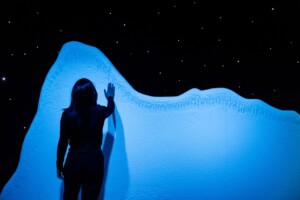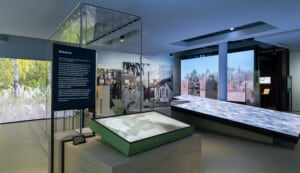Dr Emlyn Koster has been in post as CEO of the North Carolina Museum of Natural Sciences for just over a year.
During his long and successful career he has held a number of leadership positions in science centres and museums in North America, and believes that the museum profession should be taken more seriously as “necessary not just nice.”
Blooloop spoke to Dr Koster (below) about his career to date and his views on the role of the science museum now and in the future.
.jpeg) Leadership for positive change
Leadership for positive change
Dr Koster has a PHD in geology having developed an interest in natural sciences as a boy growing up on the Bournemouth Hampshire coast in England, hunting for fossils, pottering in rock pools and watching the way the land formation changed after the storms.
He graduated from Sheffield University, then emigrated to Canada to do his PHD. At this point he hadn’t decided whether to combine research with teaching or whether to concentrate purely on research, but his fascination with earth sciences continued, side by side with a developing interest in leadership. “I seemed to be interested in what made leadership for positive change, ” he says, “so I combined that with my interest in natural history…”
This was at a time when he was beginning to find researching deeply within just one facet of geology – he was studying coal in the province of Alberta at the time – somewhat limiting. It happens that in that part of the world, coal is found in the same strata as dinosaurs, and, a new Natural History museum centring on the history of life on Earth was being built.
Dr Koster describes himself as “…the lucky guy in the right place at the right time.”
He was appointed director of the Royal Tyrrell Museum of Paleontology in Alberta, launching it and opening a satellite field station in UNESCO-designated Dinosaur Provincial Park as well as integrating this new institution into the heritage tourism and scientific research professions.
Professional Provenance
After the Royal Tyrrell Museum of Paleontology, Dr Koster went on to become CEO of the Ontario Science Centre, Canada’s largest science centre. He stabilized the institution, attracted major science events with prestigious partners and integrated Ontario’s first IMAX dome theatre in a $15 million renovation.
Dr Koster then served for 15 years as CEO of Liberty Science Center, in New Jersey, where he turned financial struggles into a $109 million expansion and renewal, including a national-model contract with state government to assist at-risk communities across the state.
In January 2013 he became CEO of the North Carolina Museum of Natural Sciences.

Diverse Audiences
In the year since Dr Koster’s appointment at the North Carolina Museum of Natural Sciences he says he has "moved from net learning to net contribution", optimised the exhibits and programmes and implemented a seeking out of the value propositions that link different parts of the content with particular audiences:
“We’re all competing for people’s time and interest, and although this museum is free, it’s not excused from being very thoughtful about how to create the best possible connections between what we offer, for whom, why, and in the best possible way.”
The Smithsonian of the South
Based in Raleigh, coined “the Smithsonian of the South, ” the North Carolina Museum of Natural Sciences is increasingly, Dr Koster claims, a model of how to think in the field internationally.
It is also a premier research institution, employing 30 full-time scientists who conduct research with many local, national and international research partners. The Research and Collections Department of the Museum curates more than 3 million specimens of vertebrates, invertebrates, meteorites, rocks and fossils.
“Science surrounds us as the means by which we can better understand the challenges we face and the opportunities that are there, ” Dr Koster points out.

Evolution of Purpose
The purpose of museums has hitherto been essentially to celebrate the achievements of technology in the past. While there is still a role for this, and those collections need to be preserved for posterity, there has been an evolution of purpose in what Dr Koster calls the “consciousness of museums”: the need for a time-frame by which we can move from the past to the present, and from the present look into the future, solving the problems of today.
Dr Koster says, “By being a museum of natural sciences and not just natural history, clearly our mission entitles us to take that wide view and talk about the immensity of the Earth’s story and the continuity of time.”
This evolution of function means a common ground with and a blurring of the boundaries between museums, science centres – which don’t necessarily have collections, so have a more straightforwardly didactic role – and non-museum institutions. Elements of botanical gardens, zoos, aquaria, art galleries and history museums are freely incorporated.
Leader in the Field
Impressive, evolving and at the vanguard of public engagement and enlightenment, the North Carolina Museum of Natural Science is a leader in the field. It is themed around the following questions:
- “What do we know?”
- “How do we know?”
- “What’s happening now?”
And, maybe increasingly in the future, Dr Koster adds, “How can I, as a member of the public, at any age or stage of learning, from any economic or social background, how can I participate in the growth of knowledge about science and society and science and the environment?”
Its mission – uniquely propelled by those core questions – drives the deployment of resources to engage visitors at all ages and stages of learning. And those resources are formidable: seven floors of interactive exhibits (including a prominent theatre about climate change), coastal dioramas on coastal and sea level science, research laboratories where the public can ask questions, labs where visitors can perform experiments, a Naturalist Center with hundreds of specimens available for examination, more than 200 species of live animals that qualify the Museum as an indoor zoo, special events, such as a live uplink with the International Space Station and astronaut Tom Marshburn, and the three-storey multimedia Daily Planet Theatre with daily live presentations from scientists from the staff and from around the world.

Engagement
It is not just a museum, but a research facility, and the public can observe experiments taking place through viewing windows. In fact, they are encouraged to interact with the scientists performing research, and are invited to take part in experiments themselves.
The ‘Window on Animal Health’ is a veterinary room where visitors can watch surgery taking place on resident animals, with two-way communication between vets, students and public visitors.
On Thursday evenings the museum opens for its version of the ‘café scientifique’ theme – visitors can have a meal and a drink from a selection of North Carolina microbrews and wine in The Daily Planet Café — featuring a stage and large-screen TVs – while engaging with a scientist doing presentation in a more informal and relaxed style than in a traditional auditorium or lecture theatre. This is attracting corporate sponsors as well as visitors.
The whole mystique of science is deconstructed. Public engagement is the key, on all levels, from the youngest child to the knowledgeable post-grad.
Association of Science – Technology Centers (ASTC)
The North Carolina Museum of Natural Science is clearly then an appropriate venue for the 133rd ASTC Conference in 2014, which is dedicated to the furthering of public engagement with science and draws 2000 delegates from 650 museums in over 40 countries. (See Clara Rice's report on the 2013 ASTC Conference)
The ASTC encourages excellence and innovation in informal science learning by linking its members worldwide and advancing their common goals. ASTC also speaks on behalf of science centers and public engagement in science worldwide, and is represented at the United Nations and at regional organizations around the globe.

A Professional Sector – necessary, not just nice
It is Dr Koster’s contention that the museum profession, rich in expertise and uniquely placed between learning and entertainment, should be taken seriously as a professional sector.
Unique interactions, hands-on experiences, motivating visitors by provoking their desire to find out and lack of assessment (“Nobody passes or fails a museum, ” Dr Koster points out, quoting Frank Oppenheimer, founder of San Francisco’s Exploratorium) –all make the learning imparted in museums unlike any other.
“Society would be better served if we were regarded as a professional sector. We have expertise and we have a profile and a potential that is unique – it’s not the same as a university; it’s not the same as a hospital or any other kind of civil organisation.”
He acknowledges that it is the job of professionals in the museum sector to make this happen, adding: “We want to be necessary, not just nice.”
Doing a few things right
The North Carolina Museum of Natural Science is a dynamic, evolving and innovative resource, encouraging the public to engage with science and the issues that face science today, while encouraging visitors to return time after time with a changing programme of exhibitions and displays:
“We’re always changing exhibitions, from Birds of Paradise with National Geographic to Tropical Rainforests”. Past exhibits include Dinosaurs in Motion; Titanic: The Artifact Exhibition; Genghis Khan: The Exhibition; Our Expanding Oceans: The Blending of Art and Science.
Dr Koster concludes: “It’s a very sophisticated learning resource, and it’s become a huge attraction with over a million visitors, because I guess we’re doing a few things right.”
All images and video kind courtesy North Carolina Museum of Natural Sciences.













